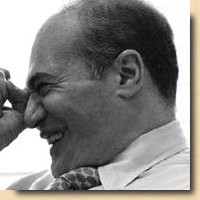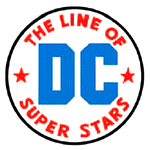|
|
| |
 SPOTLIGHT
ON SPOTLIGHT
ON
THE
1973 DC COMICS REPRINT TITLES
AN
EPISODE OF THE "WAR OF THE SHELVES"
|
| |
|
| |
| In early 1967 the
almost unthinkable happened: Marvel overtook DC in sales
numbers and became the new number one of the industry -
only five years after DC themselves had snatched that
position from Dell (who had taken a terrible tumble due
to a misfired cover price policy). This was now indeed
the Marvel Age of Comics.
But while Stan Lee, in his
April 1968
Stan's Soapbox, declared "the
fatuous little feud we've been flaunting before the
public" to be officially over and that "from
this moment on, we'll no longer refer to our competition
as Brand Echh", there was still plenty of room
to consolidate and expand the number one position.
Ever since 1957,
Marvel had been severely restricted in terms of the
number of titles they could put out every month. Due to
the bankruptcy of its new distributor, Atlas/Marvel had
no choice but to
switch to Independent News, who were owned by National
Periodical - who also happened to own rival DC Comics.
The resulting contract limited Marvel to a monthly
publishing output of eight titles only (Cooke, 1998). But
that was all to change. By the beginning of 1968,
DC Comics and Independent News were
purchased by Kinney National Company - and since Marvel's
titles were selling better than DC's, any kind of
distribution cap was lifted. The result was instantly
visible as the title
count went up from 14 for January 1968 cover month to 20
by July 1968.
Ownership changes took place at
Marvel too. On July 1st 1968, the Wall Street Journal
announced the purchase of Martin Goodman's Magazine
Management Company (including Marvel Comics) by a
business conglomerate called Perfect Film & Chemical
Corporation, owned by Martin S. Ackerman (who was also
president of Curtis Publishing). But only a year later,
in mid-1969, Ackerman was ousted from Perfect Film's
board of managers (accused of diverting $6 million in
pension funds) and replaced by new CEO Sheldon Feinberg
in mid-1969, with the company being renamed Cadence
Industries in 1970. Goodman had never had a particular
interest in what he published (Hilgart, 2014), but he was
proud of being a publisher who sold well and was able to
read trends. Feinberg, the former CFO of Revlon, was the
first in a long series of top management at Marvel who
had never read a comic book in his life, had no previous
connection to publishing, and was in it for one reason
only: to make more money.
There was just one problem: comic
book sales were in a steady decline. As a consequence,
the only way to make more money was to make sure you got
a bigger slice of the shrinking market - and one way to
achieve that was to put out more titles. And since the
space at the sales point was not going to increase, you
could at the same time push the competition (which from
Marvel's perspective of superhero titles was primarily
DC) off the shelves.
Marvel was the comic book
industry's number one, but until mid-1972 DC still
published more titles - that is until Marvel launched the
"war of the shelves" through a proliferation of
titles.
"[Marvel]
did flood the market, but remember, this was that
period (...) where Marvel suddenly decided to put out
a whole bunch of books (...) trying to get market
share (...) lots of stuff came out in the '70s
because of this approach."
(Roy Thomas, in
Cooke 2001)
By the time DC realized what was
happening, it was already too late, even though Carmine
Infantino, DC's publisher since 1971, did try to stem the
tide in 1973 by emulating Marvel and putting out a few
new as well as some reprint titles in order to boost DC's
output and keep from getting pushed off of those shelves.
It was a valiant but ultimately ill conceived move which
only had a minimal and, above all, short lived effect. By
June 1974 Marvel's titles at the newsagents outnumbered
those put out by DC by leaps and bounds.
|
| |
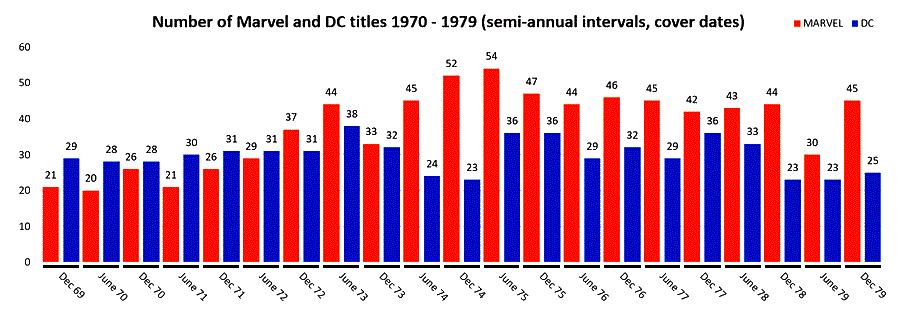
This chart doesn't take into
account black & white magazine format publications
(of which Marvel put out a cartful too).
|
| |
| The new titles all broke new
ground for DC, but their success was underwhelming to say
the least. Shazam! kicked off in February 1973 and was, of course, DC
bringing Fawcett's Captain Marvel into the fold - but
since DC couldn't call him that any more (again, Marvel
had been swifter and more cunning) they came up with
Shazam. It was a title DC had a hard time letting go, but
poor sales sank it after 35 issues in May 1978. Prez,
featuring a teenage President of the US, was launched in
August 1973 and turned out to be a total failure which
only lasted for a mere four issues. Plop!
(another title with an exclamation mark), "the new
magazine of weird humor", fared somewhat better and
at least racked up a total of 24 issues between September
1973 and November 1976. If
the new titles weren't going to stop Marvel storming away
in the title number race, maybe reprint titles would.
Infantino had of course noticed that the House of Ideas
was not only launching new titles but also busy recycling
their 1960s superhero material along with 1950s horror
and sci-fi stories from the Atlas period. However, there
was a fundamental problem there: Marvel was really good
at reprints and had material (at least as far as
superheroes were concerned) which was "classic"
but less than ten years old - and which was actually in
demand. In comparison, DC had put out only a handful of
reprint issues since the early 1960s, and most of their
Golden and Silver Age material just wasn't hitting home
with current readers any more - after all there was a
reason why Dennis O'Neil and Neal Adams had to reinvent
Batman in 1969 to save him from cancellation.
But Carmine Infantino tried hard to
turn things around (as he had indeed done in the late
1960s), and with the blessings of the top brass at DC
(Sacks, 2014) he put out a number of reprint titles in
1973 to stem Marvel's tide. Needless to say the waves
just kept coming.
|
| |
|
| |
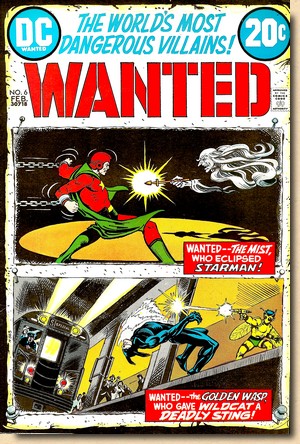
Wanted
#6
(February 1973)
|
|
WANTED
Launched -
August 1972
Cancelled - September 1973
Number of issues - 9
Strictly
speaking Wanted (sometimes also referred
to as Wanted, the World's Most Dangerous
Villains) was not part of DC's 1973 rush of
reprint titles, since it launched in August 1972.
The reason it is listed here is that five of its
total of nine issues were published in 1973, and
that it illustrates the problems DC had with its
reprint material in an exemplary way.
Wanted
was published monthly and based on an interesting
concept: Rather than spotlight the heroes, the
title featured their most notorious adversaries.
The problem was that most of the villains
showcased weren't exactly A-listers, and some of
them were downright obscure unless you happened
to be an expert on the DC superhero in question
(any takers for the Dummy, the Human Fly Bandits,
or Dr. Clever?).
DC could dig
deep into an extensive vault of previously
published material, and for Wanted they
even used material from comic books which at the
time of their original publication hadn't even
belonged to DC yet (such as Quality Comics'
somewhat unfortunately titled Doll Man).
The
fundamental problem (which few at DC seemed to
understand even in 1973) was that it wasn't just
the storytelling that was old and outdated, it
was the characters themselves.
|
|
| |
Compared to
Marvel's 1973 superhero reprint titles, which had titles
such as Marvel Super-Heroes (reprinting Hulk
stories from 1966), Marvel's Greatest Comics
(reprinting Fantastic Four material from 1966) or Marvel
Triple Action (repackaging Avengers stories from
1965) and all of which featured the new type of superhero
which had put Marvel at the top in the first place, DC
was trying to reheat twenty to thirty years old material
which compared even less favourably to Marvel now than it
had before.
The title was
discontinued after only nine issues.
|
| |
|
| |
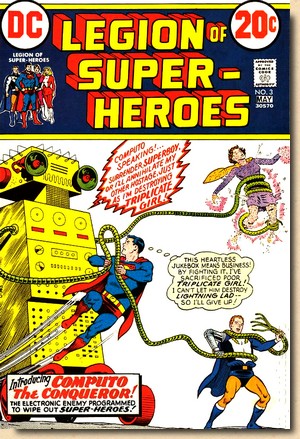
Legion of Super-Heroes #3
(May 1973)
|
|
LEGION
OF SUPER-HEROES
Launched -
February 1973
Cancelled - August 1973
Number of issues - 4
The first of
the 1973 reprint titles was Legion of
Super-Heroes, launched with a February 1973
cover date. Supplied with new covers by Nick
Cardy, it featured - no surprise, given its title
- material starring the Legion of Super-Heroes
which had previously been published between 1964
and 1966 in Adventure Comics (with
stories from Action Comics dating from
1957/58 added for the final two issues).
It switched
from monthly to bi-monthly publication after two
issues, before ceasing publication all together
after a mere four issues. While these were mostly
newer stories from less than ten years ago (and
therefore pretty much what Marvel was repackaging
in its superhero reprint titles), the already
mentioned problem was that these were 1960s
stories featuring heroes (such as Triplicate
Girl) and villains (such as Computo the
Conqueror) which had more of a 1950s feel to
them.
Now of course
DC could not reinvent itself through what had
already been published. However, material such as
this had been a contributing factor in Marvel's
success - the repetitive blandness of what Stan
Lee would increasingly enjoy calling "Brand
X" in the mid-1960s.
|
|
| |
| Considering these historical
facts, a reprint title such as Legion of Super-Heroes
with material from the mid-1960s was really not the best
idea. The majority of comic book readers must have felt
the same way, given the extraordinary short life-span of
this title. |
| |
|
| |
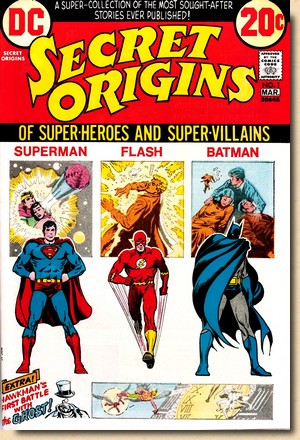
Secret Origins
#1
(March 1973)
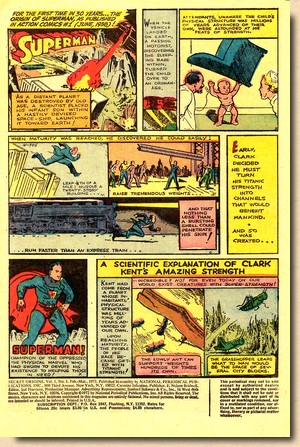
|
|
SECRET
ORIGINS
Launched -
March 1973
Cancelled - November 1974
Number of issues - 7
Only one month
later, DC launched another superhero reprint
title, and Secret Origins - which
featured the origin stories of various DC heroes
(and villains) - was arguably the most
interesting of Infantino's 1973 reprint releases.
Strictly speaking, this was actually volume 2 of Secret
Origins, since DC had released a 84-pages
one-shot with the same title (and concept) back
in 1961, but the indicia of Secret Origins
#1 from March 1973 simply ignored that and stated
"Vol. 1 No. 1".
The first
issue featured origin stories of Superman (from Action
Comics #1, June 1938), Batman (first two
pages from Detective Comics #33,
November 1939), Ghost (from Flash Comics
#88, October 1947), and Flash (from Showcase
#4, September 1956). It also featured an entire
page penned by editor E. Nelson Bridwell,
providing some background for the title.
"When we decided to
publish a comic magazine featuring the
origings of the great DC heroes and villains,
we began digging back into the past to find
when and where the origins were first
printed. We made some surprising discoveries.
Take Superman.
His origin was first told in Action
#1 - yet that version was
one which had never
been reprinted! What a collector's item! So
you have it at last - in this mag."

DC was
definitely trying, and more mature comic book aficionados
will no doubt appreciate the depth of DC's
history and the material made available in Secret
Origins. But if you weren't a die-hard DC
fan at the time (and after all Infantino and
Bridwell were trying to at least hold their
ground if not expand their market base here), Secret
Origins was probably only able to generate
limited interest.
Marvel even
put DC in a tight spot in terms of sales pitch
terminology; after all, how often had Stan Lee
told potential buyers in a cover or splashpage
blurb that they were looking at an "instant
collector's item" - not from 1938, but fresh
off the press.
It probably
also didn't really help that Superman and Batman
together only covered a total of 3 pages, whereas
the Ghost got 9 and the Flash 12. In that
respect, Nick Cardy's newly produced cover was
nice, but slightly misleading.
|
|
| |
| Secret Origins #2
featured the origin stories of Supergirl (from Action
Comics #252, May 1959), Green Lantern (from Showcase
#22, September 1959), and the Atom (from Showcase
#34 (September 1961). E. Nelson Bridwell again provided
some background (on the origins of Green Lantern and the
Atom), but this was now down to one third of a page.
Secret Origins #3 was down to two
reprinted origin stories, those of Wonder Woman (from Wonder
Woman #1, Summer 1942) and Wildcat (from Sensation
Comics #1, January 1942). The title was still on a
bi-monthly schedule but appeared in the July/August 1973
publication slot. This was because DC discovered another
point that put them at a disadvantage with Marvel - cover
dates.
"Cover dates on comics
didn't match magazine dating norms, and by 1973
Marvel's cover dates made them appear newer than
DC's, so DC decided to skip using May 1973 and go
straight to June." (Levitz, 2010)
Continuing deep into Golden Age
territory, Secret Origins #4 featured Western
hero The Vigilante (from Action Comics #42,
November 1941) and Kid Eternity (Hit Comics #25
, December 1942 and published at the time by Quality
Comics).
|
| |
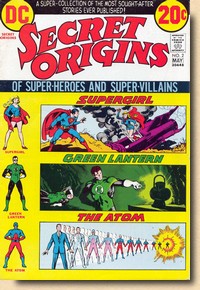 Secret
Origins #2 Secret
Origins #2
(May 1973)
|
|
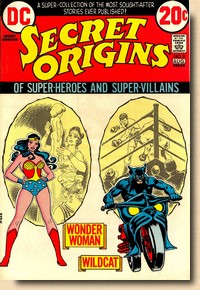
Secret Origins
#3
(August 1973)
|
|

Secret Origins
#4
(October 1973)
|
|
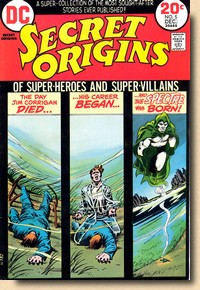
Secret Origins
#5
(December 1973)
|
|
| |
| Secret Origins #5 only
featured one single character, but although this was
another dip into Golden Age material (from More Fun
Comics #52 and #53, February and March 1940), the
Spectre must have been a lot more familiar to the average
reader than the previous issue's protagonists. |
| |
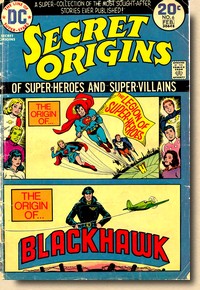 Secret
Origins #6 Secret
Origins #6
(February 1974)
|
|
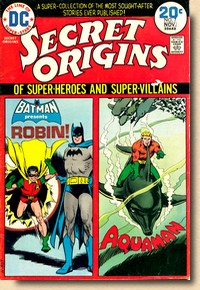
Secret Origins
#7
(November 1974)
|
|
Secret
Origins #6 not only had more familiar
characters in the form of the Legion of
Super-Heroes, their origin story was also a lot
more recent material (originally published in Superboy
#147, May 1968). The Golden Age did pop up again,
though, for the origin of Blackhawk (from Military
Comics #1, August 1941, published by Quality
Comics). With the
indicia still calling it a bi-monthly title, Secret
Origins #7 didn't make it to the newsstands
until November 1974, missing three publication
slots and thus with a delay of six months.
Featuring Robin (from Detective
Comics #38, April 1940) and Aquaman (from More
Fun Comics #73, November 1941), this was to
be the title's last hurrah - unbeknownst to
readers and possibly even the editor, since the
letters page makes no mention of neither the
delay in getting this issue out nor the fact that
it will be the final one. As a matter of fact,
readers were even told to keep the letters
coming.
|
|
| |
However, regular comic book
readers knew that a lengthy hiatus between two issues
hardly ever pointed to something good, and certainly not
with a bi-monthly title. The plug was obviously pulled
after all the copy for Secret Origins #7 was
already done and ready for the printers, and nobody was
going to put in an extra effort to announce the
cancellation. Interestingly enough, there are - although
admittedly with the benefit of hindsight - a few
indications which underscore the problems DC was facing
with titles such as Secret Origins. Two in-house
ads show that DC had, by now, decided to go with
characters and titles that had a long standing and were
well know (Superman leading the way, but also
including Kirby's Kamandi and, interestingly,
the reprint Black Magic, as well as popular
culture icons such as The Shadow) - and that, as
far as the war of the shelves was concerned, DC decided
to fight back with bigger titles instead of more titles.
"What DC lacked in
quantity, it (...) made up for in size. The majority
of Marvel's comics were in the standard 36-page, 25¢
format, with its Giant-Size books delivering 68 pages
for 50¢. DC, on the other hand, dove back into the
giant-size comics in a big way in early 1974 (...)
Twelve ongoing comics were published as 100-page
bi-monthly series between March 1974 and April 1975 -
nearly a third of National's full line of books at
the time (...) [featuring] a mix of new stories
alongside reprints of classics culled from DC's deep
library of archival material." (Sacks,
2014)
|
| |
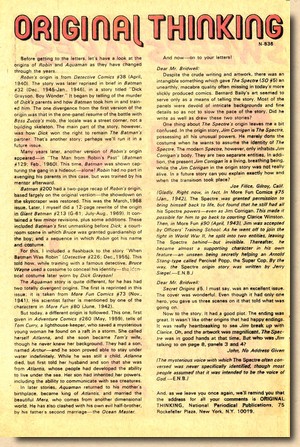 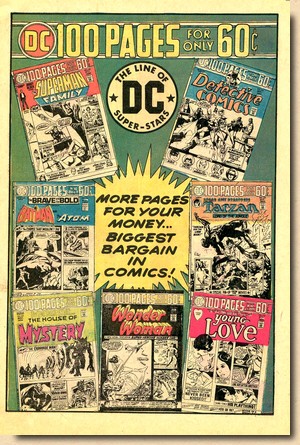 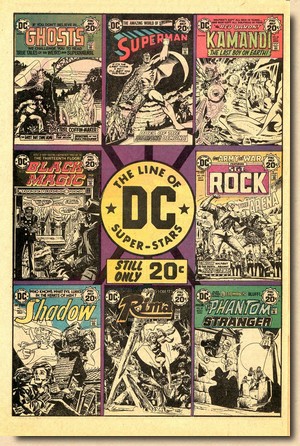 |
| |
| DC simply had a fundamental
problem with its reprints, mirrored by a letter published
in Secret Origins #7, where a reader wrote about
the "crude writing and artwork"
(concerning the Spectre story from 1940). The material
was, quite simply, too old and couldn't even compare
favourably with Marvel's reprints of the Lee/Kirby/Ditko
monster stories from the 1950s. In DC's defence, it has to be said that -
according to the Statement of Ownership, Management,
and Circulation (which had to be printed once every
twelve months in order to qualify for Second Class
shipping for printed matters) - Superman was
still the best selling title across the board in 1973,
with an average of 309,300 sold copies per issue. The bad
news was that Amazing Spider-Man had
continuously been closing the gap, selling an average
273,400 copies per issue in 1973 (while Batman
stood at 200,500). Only one year later, in 1974, Amazing
Spider-Man would edge past Superman
(288,200 versus 285,600), and whilst the Man of Steal
managed to claw back once more in 1975, Amazing
Spider-Man would just keep pulling away as of 1976 -
all to the tune of dropping sales figures across the
board. These numbers are just another indication that
Marvel's "new" kind of superhero was clearly
ahead of DC's more "traditional" fare in terms
of popularity and therefore sales. Marvel was winning the
contest for very specific reasons, and a reprint title
such as Secret Origins not only failed to
address those, it almost amounted to putting DC's
shortcomings on display for all to see (possibly even
more so than Legion of Super-Heroes).
"[DC] were getting
their asses kicked in by Marvel at the newsstands
[but] they were not reading the Marvel books - never
analyzing or trying to figure out what the
competition was doing (...) you would talk to these
people and they wouldn't know what was going on in
the business except at DC Comics." (Joe
Orlando, in Infantino & Spurlock, 2001)
But maybe DC was just throwing
titles out there - not unlike Marvel - with a "what
the heck" attitude. If it sank, it at least got a
certain presence on the newsagent shelves for a while.
For Secret Origins, that presence ended, after
only seven issues, in November 1974.
|
| |
|
| |
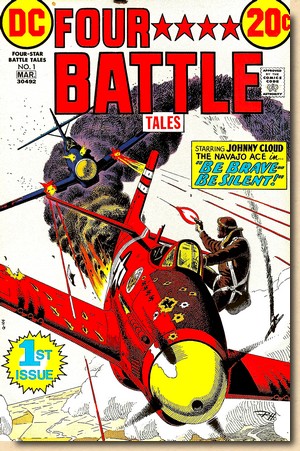
Four Star Battle Tales
#1
(March 1973)
|
|
FOUR
STAR BATTLE TALES
Launched -
March 1973
Cancelled - November 1973
Number of issues - 5
Four-Star
Battle Tales started its short publication
life with a cover date of March 1973. As the
title implies, it reprinted 1950s and 1960s
covers and stories from All-American Men of
War, Star Spangled War Stories, Our
Army at War, Our Fighting Forces,
and G.I. Combat.
Some of the
talent was still associated with war genre comic
books at the time (such as Joe Kubert, who
received a special profile page in Four-Star
Battle Tales #4), while others pencillers
had since moved on to DC superheroes (such as Irv
Novick). Special editorial pages looked at
science-fiction war stories (issue #5) or the
personality of Lawrence of Arabia (issue #1).
In 1973, DC
had the market pretty much covered for war
comics, and most of the titles which served as
source for the reprints in Four-Star Battle
Tales were still ongoing books: Our Army
at War (featuring Sgt Rock), Our
Fighting Forces (featuring the Losers), G.I.
Combat (featuring the Haunted Tank), and Star
Spangled War Stories (featuring the Unknown
Soldier). Added to that fold was the
genre-crossover title Weird War Tales.
Trivia note:
Although the indicia identified the title as Four-Star
Battle Tales, the cover copy actually always
displayed the title as Four **** Battle Tales.
|
|
| |
|
| |
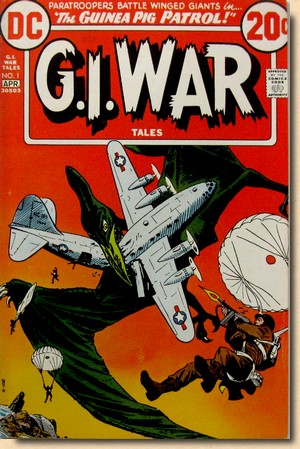
G.I. War Tales
#1
(March 1973)
|
|
G.I.
WAR TALES
Launched -
March 1973
Cancelled - October 1973
Number of issues - 4
G.I. War
Tales was also launched in March 1973, and
just like Four-Star Battle Tales reprinted
1950s and 1960s covers and stories from Star
Spangled War Stories, Our Fighting Forces, Our
Army at War, All-American Men of War,
and G.I. Combat - in other words exactly
the same sources.
As mentioned,
DC had been the undisputed number one in the
field of war comics for a long time, with strong
original characters and highly influential
creative talent.
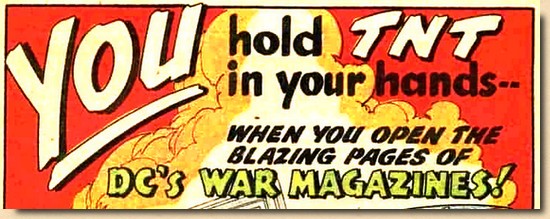
|
|
| |
| Throwing out two reprint titles at
the same time was clearly a grab for shelf space, but it
was also a legitimately valid business idea. Unlike with
superheroes, material from the 1950s and 1960s was still
valid fare for fans of war comics. However, even so, G.I.
War Tales got decommissioned after only four issues.
|
| |
|
| |
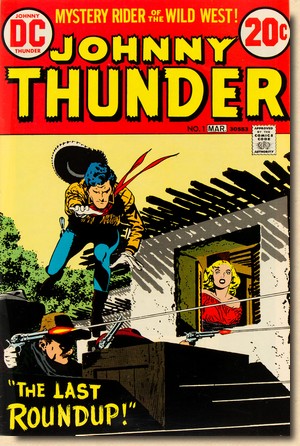
Johnny Thunder
#1
(March 1973)
|
|
JOHNNY
THUNDER
Launched -
March 1973
Cancelled - August 1973
Number of issues - 3
Johnny
Thunder was the first of two western genre
reprint titles DC launched in 1973; as the title
implies, it featured stories starring John Tane.
The son of a sheriff, he followed in his mother's
footsteps and became a schoolteacher but finds
himself increasingly at odds with the promise he
made to his mother never to use guns. In order to
keep his vow yet still fight the evil he
encounters the way his dad did, he creates a
fictional persona named Johnny Thunder, the
identity of which he assumes by changing clothes
and blackening his hair.
With an origin
story that clearly leans into the general
superhero concept of a "secret
identity", Johnny Thunder was created by
Alex Toth and Robert Kanigher for All-American
Comics #100 (August 1948) - and was actually
one of the first non-superhero characters
published by DC Comics. All-American Comics
would be renamed All-American Western in
November 1948 with Johnny Thunder as the cover
feature. Editor E. Nelson Bridwell again provided
some background information on Johnny Thunder in
issue #1.

|
|
| |
| Western comics became popular in
the years immediately following World War II when
superheroes went out of style, and all of the big comic
book publishers started putting out Western titles around
the time DC launched Johnny Thunder. Their popularity
peak around 1960 (not the least because Westerns were all
over American TV) before the genre in general started to
lose its appeal. As far as comic books were concerned,
the interest swung back to superheroes, although a
handful of titles remained, answering to a (fairly solid)
niche demand. DC had tried to
latch onto the darker reflection of the Wild West shown
by Western movies of the 1960s by setting up a
"weird western" sub-genre in 1968, ultimately
leading to Weird Western Tales in 1972 and its
newly created Western anti-hero Jonah Hex. The formula
worked, and editor Joe Orlando even derided Marvel's more
traditional Western fare ("Kid titled Western
heroes") on the letters page of
Weird Western Tales #15 (December 1972):
"It's really a
pleasure to see hard work rewarded. It would have
been much easier to put out half a dozen
"Kid" titled Western heroes - all fighting
in improbable situations - and all exactly alike.
Time has been taken to develop all the characters
that have appeared in WWT [Weird Western Tales] -
beginning with Outlaw and El Diablo and through Billy
the Kid and Jonah Hex. It has been our thought that
quality Western stories can exist (...) We will
continue to take the time to develop our characters
rather than merely xerox them."
|
| |
In that sense, Johnny Thunder
was somewhat out of time, reprinting stories
originally published between 1948 and 1957 in All-American
Western, All Star Western and Western
Comics. In issue #1 E. Nelson Bridwell had
encouraged readers to send in their feedback, and
in issue #3
revealed that exactly five had done so - and
that this would be the last of Johnny Thunder.
"This
page contains all the letters received so far
on the first issue! That may help to explain
why this is the last issue of Johnny Thunder
(...) maybe today's Western readers go more
for the Jonah Hex type than the clean-cut
range riders of the past."
Maybe E.
Nelson Bridwell ("Mr. Bridwell" to four
of the five letter writers) should have just
asked Joe Orlando beforehand.
|
|
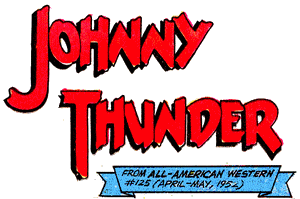
|
|
| |
| From a more general perspective, Johnny
Thunder #3 shines an odd light on DC Comics. While
one might applaud the editors for not trying to simply
copy Marvel's flamboyant style and Stan Lee's hyperbole,
the tone displayed here is right at the opposite end of
the scale, as editor Bridwell comments on the
cancellation of Johnny Thunder with "at
least Shazam! is doing well" and an in-house ad
for the new and upcoming Prez title simply
states "coming".
It all felt very underwhelming, rather resigned, and even
self-deprecating - almost as though DC knew it was losing
ground to Marvel but still, and for the life of them,
just couldn't figure out and understand why. |
| |
|
| |
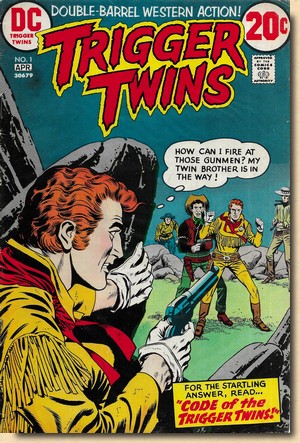
Trigger Twins
#1
(April 1973)
|
|
TRIGGER
TWINS
Launched -
April 1973
Cancelled - April 1973
Number of issues - 1
Trigger
Twins has the dubious honour of being the
1973 reprint title with the fewest issues - one.
As its title implies, it reprinted two 1957/58
stories from All Star Western featuring
the Trigger Twins as well as one 1960 story
featuring Pow-Wow Smith from Western Comics.
The cover itself is a reprint (as was th case
with all three of the Johnny Thunder
covers), taken from All Star Western #94
(April 1957).
The Trigger Twins first
appeared in All-Star Western #58 (May
1951), created by Robert Kanigher and Carmine
Infantino. The core idea was a sheriff named Walt
Trigger who, unbeknownst to the general public,
has a twin brother (Wayne Trigger) who isn't in
law enforcement but is more accurate and faster
on the draw with firearms than his brother. As a
consequence (and running theme) Wayne
impersonates Walt repeatedly - and even requires
a twin of Walt's horse to make sure no one
suspects the switch of the two twins.
Not
surprisingly, this concept didn't really hold up
for long. Again, as with the other reprint
titles, E. Nelson Bridwell introduced the
backgrounds of the Trigger Twins and Pow-Wow
Smith but already mentions that "due to
scheduling changes, it is only planned as a
one-shot (unless it sells very well, in which
case a comeback is possible)".
|
|
| |
| The indicia was even more
optimistic than Bridwell entertaining the possibility of
the title selling "very well", indicating a
bi-monthly publication schedule. But the reality was that
Trigger Twins didn't survive the first standoff. |
| |
|
| |
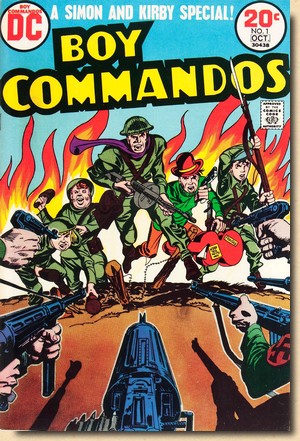
Boy Commandos
#1
(October 1973)
|
|
BOY
COMMANDOS
Launched -
October 1973
Cancelled - December 1973
Number of issues - 2
DC had thrown
out a number of reprint titles for the first
quarter of 1973, but a few months into that year
realized that none of it was selling. Having seen
superhero, war and western material fizzle out,
Infantino made a last effort ditch to stem the
tide of Marvel titles (which was still surging
and hitting the newsstands relentlessly) at least
a little bit. And this time, DC would bring out
its secret weapon - the thorn in Marvel's side:
Jack Kirby.
It was already
over two years ago that Carmine Infantino had
contracted Kirby away from Marvel (back in
February 1970), but "the King" leaving
the House of Ideas had caused shockwaves. Maybe
some of that party killing effect could be
repeated.
In putting out
Boy Commandos (volume 2) for the October
1973 cover date production cycle (issue #1
actually went on sale at the end of June), editor
E. Nelson Bridwell certainly tried to make
certain that readers knew this was Kirby - a
"Simon and Kirby Special", in fact.
Inside, readers would find some of the very first
Boy Commandos stories Simon and Kirby had
created, back in 1942, when they had been signed
on by DC, and "kid gangs" seemed to be
increasingly popular.
|
|
| |
| But the rather unfortunate
Bridwell - who again put together some background notes
for Boy Commandos #1 - was faced with the
familiar problem these reprint titles all shared (yes, it
was Kirby, but it was mid-1940s material and it felt old,
even by reprint standards). Plus he had a new problem,
too - the label "Kirby" wasn't really selling
all that well at DC. Most of his Fourth World titles had
been cancelled the year before, and in August 1973 Kirby
would be notified that Mister Miracle would be
dropped as well. Kid gangs
were no longer popular in 1973, and Boy Commandos
folded after only two bi-monthly issues, only just making
it past Trigger Twins.
|
| |
|
| |
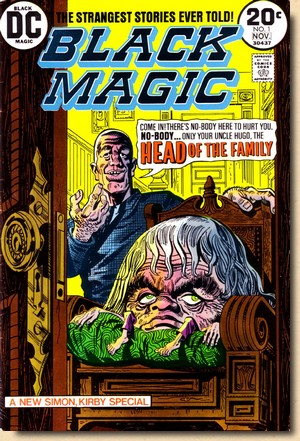
Black Magic
#1
(November 1973)
|
|
BLACK
MAGIC
Launched -
November 1973
Cancelled - May 1975
Number of issues - 9
The final
reprint title that DC launched in 1973 was
another "Simon / Kirby Special": Black
Magic. Reprinting stories from the mid-1950s
Prize Publications series of the same title
(Prize left the comic book business in 1963,
selling their properties to DC), there was no
background information from E. Nelson Bridwell
for Black Magic, since Joe Simon himself
was the editor of the reprint title.
Published
every other month, Black Magic was
probably the closest DC ever got to Marvel's
reprint titles (some of which also repackaged
1950s Kirby monster fare), although ironically
the material
wasn't actually marked as reprints, neither through an editorial
textbox on the first page of the stories nor in
the indicia (a somewhat frivolous procedure, but
one also pursued for a time in the late 1960s by
Marvel, although they never completely dropped
the word "reprint" from the
indicia).
Black
Magic would last for nine issues until the
curtain call came in May 1975, and when it did
bow out, it was the last title standing from
Infantino's 1973 attempt to curb Marvel's attempt
to bully DC off the newsstands and shelves.
It is probably
also the 1973 reprint title which today enjoys
the most attention, since the nine Black
Magic titles provide a far easier access to
these stories than the original first volume
issues do.
|
|
| |
| However, some of the artwork had
been reworked for the reprints, and since the original
Prize issues were pre-code, a few actual alterations had
to be made in 1973 in order to conform to the Comics Code
(Mendryk, 2009). |
| |
| |
|
| |
| To say that DC Comics lost the
"war of the shelves" would be an
understatement; by the end of 1974, Marvel titles on the
newsstands outnumbered DC's two to one. |
| |
And although that kind of expansion
would not prove sustainable for the House of
Ideas, the lines were drawn.
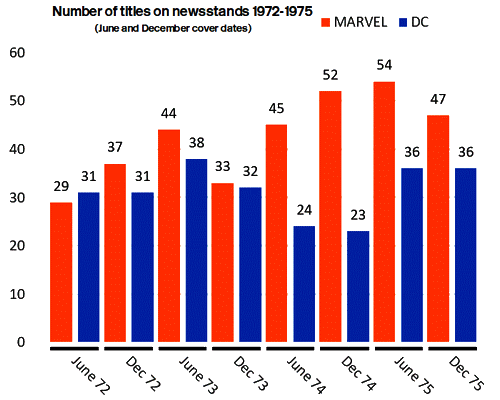
This was also true in terms of
publishing policies. Halfway through the year
1973 DC dropped the attempt of bolstering the
title range by having regular comic books
featuring only reprint material and instead went
for the 100 pages Super Spectacular
formula, combining some new material with mostly
reprint pages.
In fact, when
Detective Comics changed to
the 100 pages format for its December/January
1973/74 issue, a lot of the reprint material
wasn't even Batman related...
|
|
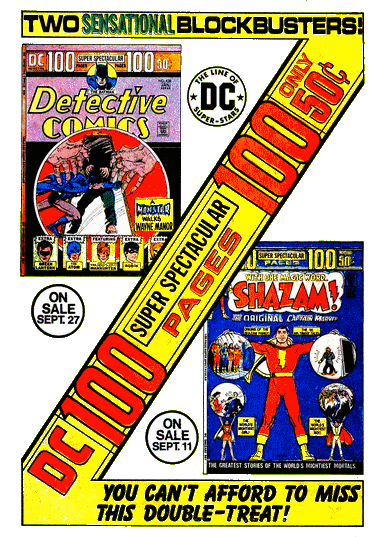
... as astute
readers could notice in advance from the cover of
Detective
Comics #438
shown
in an in-house ad from Black Magic #1).
|
|
| |
It seemed like this was the only
way DC could sell any reprints at all: if readers wanted
to keep following their favourite hero's current
adventures they would have to put up with getting any and
all kinds of reprint material stuck into that same comic
book. And naturally, they would have to pay extra for
that. Not surprisingly, the move wasn't really the silver
bullet DC may have hoped for.
"While the 100-page
package was popular with DC's staffers, it faced
resistance from both fans and distributors (...) some
consumers balked at the inflated price point,
especially because the majority of material within
each issue was reprints."
(Sacks, 2014)
DC was trying different publishing
concepts for their reprint material, but unlike Marvel,
they didn't really have an idea of how to sell it -
something which the House of Ideas had been doing
systematically (and very successfully) since the early
1960s. But then, as pointed out again and again here, the
fundamental problem was that DC's archival material
simply wasn't in demand - it was the old stuff that had
been pushed aside by Marvel's new approach to comic books
since 1961. Even Carmine Infantino himself knew that all
too well, reflecting on his promotions to Editorial
Director in 1967 and then DC's Publisher in 1971:
"The DC books were
very sterile-looking in those days."
(Infantino & Spurlock, 2001)
Of course that was exactly the type
of material (or even older) that DC was trying to sell as
reprints in 1973. But unlike today, there was no sizeable
customer base made up of adults who either felt nostalgic
or were interested in comic book history. Kids and
teenagers wanted new, exciting stuff.
|
| |




























